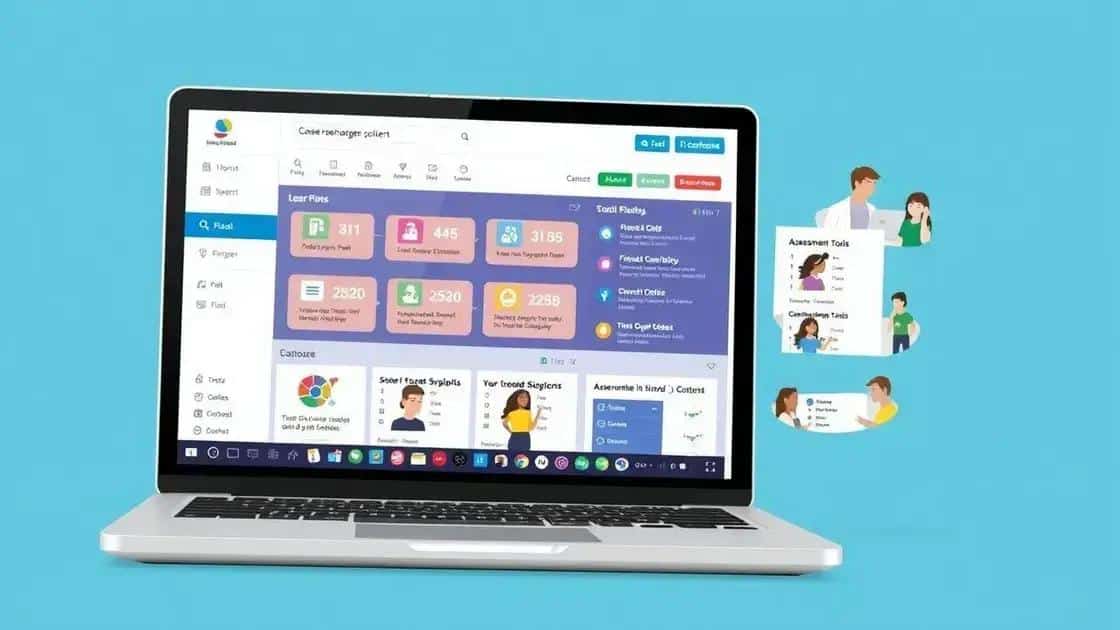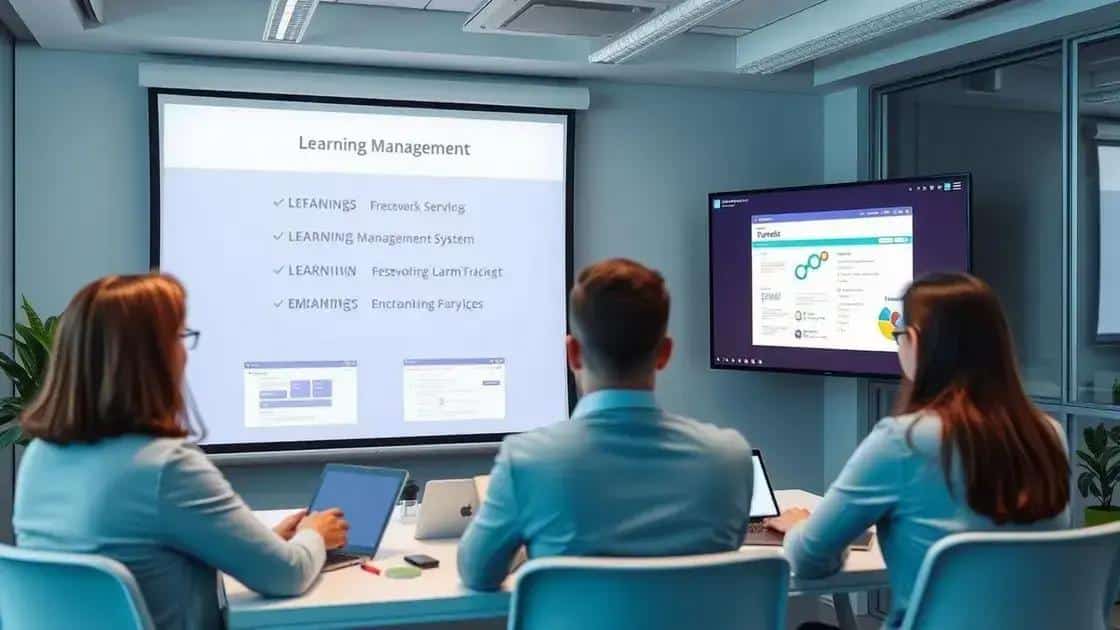Learning management systems: the key to effective education

Learning management systems (LMS) enhance education by providing accessible course materials, customizable learning paths, and efficient tracking tools that support learners and educators alike.
Learning management systems have transformed education and training by making content accessible, engaging, and personalized. Have you ever wondered how these tools can reshape your learning experience? Let’s dive into their world.
Understanding learning management systems
Understanding learning management systems (LMS) is crucial for educators and organizations looking to enhance their training and educational processes. These systems provide a centralized platform for managing, delivering, and tracking learning content.
What is a Learning Management System?
A learning management system is software that administers, documents, tracks, and delivers educational courses or training programs. Learning happens either online or in a traditional classroom setting. It allows users to access materials anytime and anywhere, ensuring flexibility and convenience.
Key Components of a Learning Management System
Most LMS platforms include certain essential features that support learning:
- User Management: Admins can track user progress and engagement.
- Content Management: Course materials can be uploaded and organized efficiently.
- Assessment Tools: Quizzes and tests can be created to measure learning outcomes.
- Reporting and Analytics: Insights into student performance and engagement can be gathered.
These features ensure that learning management systems cater to both educators and learners by streamlining the educational process. With the ability to provide personalized learning paths, LMS platforms open up new avenues for engagement.
Furthermore, modern LMS solutions support various multimedia formats, allowing instructors to create engaging courses tailored to diverse learning styles. For instance, incorporating videos, interactive quizzes, and discussion boards enhances the overall learning experience, making it more effective and enjoyable.
Benefits of Using Learning Management Systems
Implementing an LMS in your organization brings numerous advantages:
- Increased Efficiency: Saves time in course management and administration.
- Enhanced Learning Experience: Offers a more tailored educational journey for students.
- Cost-Effectiveness: Reduces costs associated with traditional teaching methods.
Overall, understanding how learning management systems function and their benefits can help organizations make informed decisions. They play a pivotal role in shaping how education is delivered and consumed in today’s digital landscape.
Key features of effective learning management systems

Key features of effective learning management systems help in shaping an efficient learning environment. Understanding these features allows organizations to choose the right LMS that meets their educational needs.
1. User-Friendly Interface
An intuitive and user-friendly interface is essential for both instructors and learners. A system that is easy to navigate encourages higher engagement and better learning outcomes.
2. Customizable Learning Paths
Effective LMS platforms allow for the creation of customizable learning paths. This means users can tailor their educational journeys, selecting courses that align with their skills and interests.
- Students can progress at their own pace.
- Instructors can recommend specific paths based on performance.
- Flexibility in learning enhances motivation.
Having this feature promotes a personalized learning experience, which can lead to improved knowledge retention and application. Additionally, flexibility in learning gives learners the control they desire in their educational pursuits.
3. Assessment and Feedback Tools
To track progress and assess understanding, effective learning management systems include various assessment tools. These tools help instructors gauge student performance accurately.
- Quizzes and exams can be easily created and scored.
- Feedback can be given instantly, allowing for prompt improvement.
- Performance analytics provide valuable insights for both learners and educators.
The ability to monitor progress through assessments allows for timely interventions when necessary. Moreover, constructive feedback is essential for learner development.
Another critical feature is mobile accessibility. As technology evolves, learners expect to access their courses anytime, anywhere. An effective LMS offers mobile compatibility, providing a seamless experience across devices.
This accessibility encourages continuous learning by allowing users to engage with content during their commute or spare time. Ultimately, these features combine to create an effective platform for enhancing education.
Benefits of implementing learning management systems
Implementing learning management systems (LMS) brings multiple benefits that significantly enhance the educational experience. From improving accessibility to providing detailed analytics, these systems offer solutions that cater to various learning needs.
Enhanced Accessibility
One of the key benefits of an LMS is enhanced accessibility. Learners can access course materials anytime and from anywhere. This flexibility allows learners to fit education into their busy schedules, which can lead to increased participation and engagement.
Cost-Effectiveness
Another important advantage is the cost-effectiveness of learning management systems. By reducing the need for physical materials and classroom space, organizations save money. Furthermore, online training can lower travel expenses associated with traditional training methods.
- No need for printed course materials.
- Reduced costs for in-person training.
- Scalability for a larger audience without additional expenses.
This cost efficiency makes LMS a practical choice for organizations of all sizes, allowing for better allocation of resources. Moreover, the low operational cost compared to traditional learning methods makes it an attractive option.
Improved Tracking and Reporting
Effective LMS solutions provide powerful tracking and reporting features. Instructors can monitor student progress and engagement, gaining valuable insights into their learning journeys.
- Real-time performance tracking helps identify areas for improvement.
- Customizable reports can showcase detailed data on learner success.
- Analytics can inform strategies for enhancing course materials.
These features enable prompt interventions for struggling students, ensuring that all learners can achieve their goals. By leveraging data effectively, organizations can continually improve their educational offerings.
Additionally, a well-implemented LMS promotes collaboration and communication among learners and instructors. Discussion forums, chat features, and interactive tools enhance the learning experience, fostering an active learning community.
As a result, learners not only benefit from accessing content but also from engaging meaningfully with their peers and instructors. In summary, the benefits of adopting learning management systems extend beyond mere convenience. They create a comprehensive and effective learning environment.
Best practices for choosing a learning management system

Choosing the right learning management system (LMS) is essential for achieving effective education and training outcomes. By following best practices, organizations can select a system that meets their unique needs and enhances the learning experience.
Identify Your Goals
First, it is important to clearly define your goals for implementing an LMS. Understanding the specific needs of your organization can guide the selection process. Consider what you want to achieve, whether that’s improving engagement, reducing costs, or increasing accessibility.
Evaluate Features and Functionality
Once you have identified your goals, evaluate the features and functionality of potential systems. Look for key attributes that will support your learning objectives.
- Customization: Can the LMS be tailored to suit your specific needs?
- User Experience: Is the interface intuitive for both instructors and learners?
- Integration: Does it integrate well with existing tools and software?
- Mobile Compatibility: Can learners access the platform on various devices?
By examining these features, you can better understand how each LMS will meet your expectations.
Consider Scalability
Another important factor is scalability. As your organization grows, your LMS should be able to accommodate an expanding user base and increasing course offerings. Selecting a system that can grow with your organization ensures long-term value and sustainability.
Another consideration is the support and resources available. Will the LMS provider offer adequate support if issues arise? Comprehensive training for users and ongoing technical assistance can be vital to a successful implementation.
Demoing potential systems can also provide valuable insights. A live demonstration allows stakeholders to interact with the interface and explore features firsthand. Engaging with the LMS before purchase can uncover important details that may not be evident in product descriptions.
Lastly, gather feedback from stakeholders and future users. Input from learners, instructors, and administrators can provide diverse perspectives on what features are most desirable. This collaborative approach can lead to a more informed decision when selecting the best LMS for your organization.
FAQ – Frequently Asked Questions about Learning Management Systems
What is a learning management system?
A learning management system (LMS) is software used to manage, track, and deliver educational courses and training programs.
How can an LMS improve accessibility?
An LMS allows learners to access course materials anytime and anywhere, making education more flexible and convenient.
What features should I look for in an LMS?
Key features include user-friendly interfaces, customization options, integration with other tools, and mobile compatibility.
Why is it important to gather feedback from users?
Feedback helps identify user preferences and issues, ensuring that the chosen LMS meets the needs of both learners and instructors.






